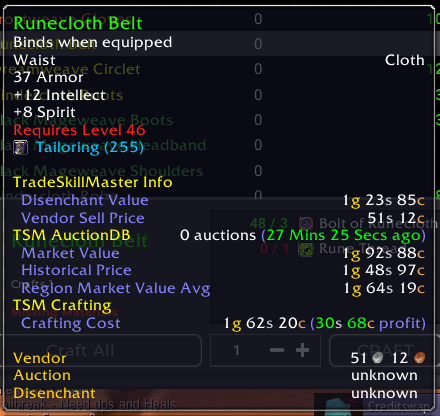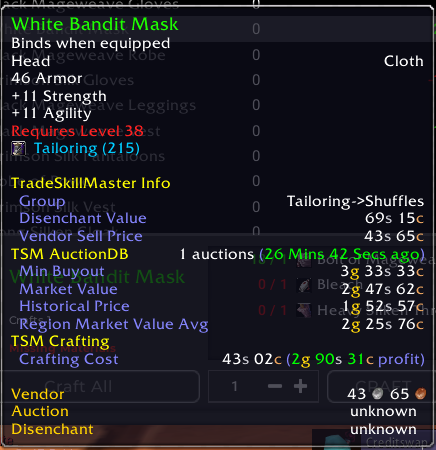Enchanting shuffles have always been a staple of goldmaking strategies. The basic idea is to mass craft some item and then disenchant it for enchanting materials. I theorycrafted about this before classic launched, so let’s see how it actually looks.
Essences are the bottle neck
Generally speaking the essences that you get from enchanting are much harder to get relative to how many you need. So for any disenchanting in classic, the essences will be where you make your gold.
The reason for this is primarily due to how disenchanting works in classic, so let’s take a look at that
Material yields and the math behind
When you do enchanting shuffles you want to make sure you are profitable on average. There’s always some degree of variability in what you get.
In classic a uncommon item can disenchant into dust, essences or shards. The item type, specifically whether it is a weapon or a piece of armor determines the chance for the various types of enchanting materials.
The level of the item will then decide which level of materials you get.
Armor yields
Armor will usually have a 75% chance of disenchanting into dust, about a 20 % chance to disenchant into essences and about a 5 % chance to disenchant into a shard. The exact percentages varies a bit between levels of the item in question.
Weapon yields
Weapon yields are similar to armor, except the dust and essences swap chances. So you have 20 % chance of getting dust and a 75% chance of getting essences.
Since players disenchant way more armor than weapons, as it drops significantly more often, we usually end up with relatively speaking a lot of dust, and not that many essences. So we see that essence prices, particularly in the end game are overall very high.
Shuffling for essences
Ideally we would want to shuffle weapons for the juicy 75% chance of getting essences, but sadly all the weapons are too expensive to be worthwhile. To maximize the gold per hour we will only focus on the two highest level essences: eternals and Nether Essences.
Both are used in several in demand enchants and command high prices. The region value for the greater versions of these two are 8 and 3 gold respectively.
Finding recipes that are profitable
Prices vary between realms, so I’ve gone through a lot of the candidate recipes in both leatherworking and tailoring I could find. Overall it seems like the White Bandit Mask recipe for tailoring is the best bet for Nether essences. For Eternal essences the best bet seems to be leatherworking, specifically Wicked Leather Headband and Heavy Scorpid Belt.
I’ve made a simple google sheet that utilizes the Nexushub.co API to get prices for your realm. it then compares a list of recipes I’ve implemented to find which are profitable on your realm. The API can be a bit slow, so make sure all the materials have prices in the material prices pane before you start investing.
TSM also does a fairly good job of estimating the disenchant value and crafting cost, but this only works if you have the recipe already. You can see in the screenshots that white bandit masks are profitable on my realm, while runecloth belts cost more to craft than the enchanting materials are worth.


Doing the shuffle
Obviously you need the profitable recipes. Then it’s as simple as buying materials at market value, crafting the items, and mailing it all to a disenchanter. You can disenchant everything on a level 5 character, so this part of the equation is very easy. If you’re missing a max level crafter for leatherworking or tailoring it will take quite a bit of more time to get rolling.
For posting the materials I suggest just using my settings for material flipping. These have worked really well for selling for me. There’s no deposit cost for enchanting materials, so you can just go as crazy as you want to.

Calculated this for my realm and I basically break-even every time, that is IF I get lucky on the 20% & 5% disenchants
That sucks. Not every method will work on every realm sadly.
I created a copy of your spreadsheet to play around with it, and I found that the api just would not import the data for runecloth and rugged leather no matter how long I gave it. Perhaps due to the high volume? Anyway I looked up the prices manually on nexus hub, entered them, and eureka. Cool little tool. Margins are there, but it’s probably not high enough on my server to warrant the work required to buy mats, craft, mail, disenchant, and repost. Was interesting nonetheless. Would spend another hour on similar projects while in quarantine.
Nice to hear you enjoyed it. Margins seem surprisingly thin across the board in classic, which is disappointing.
For some reason this is no longer working, Runecloth and Rugged leather return invalid data and break the whole sheet. I tried tinkering or manually entering a value and just couldnt get it fixed.
I’ll take a look, I assume the API return string may have changed.
Sheet is still broken unfortunately.
I had to change one cell (in the Material Prices tab, cell C28, Runecloth price, for whatever reason, is pulling from the same column as others, but the cells are pushed over one in the Runecloth row. Changing the formula manually in that cell to “=substitute(X28…” worked.
I’ve been trying to build a crafting operation around this with minimum profit tied to disenchant value for wotlk classic so I can log my tailor/lw/enchanter and restock most profitable option (soul dust, dream dust, illusion, arcane dust) and gather from AH upto whatever price point works. So far I can’t seem to get one working without manually doing some math. Anyone have an example or is it only spreadsheet based.